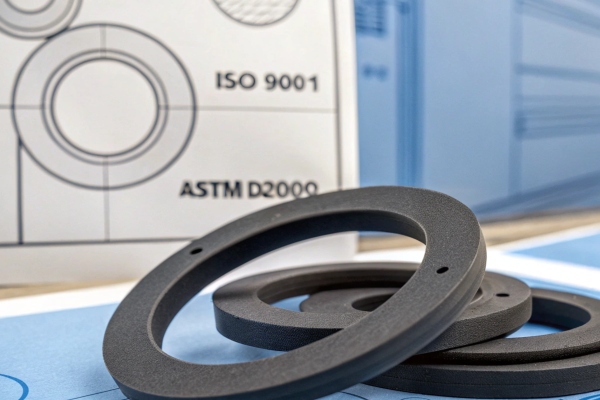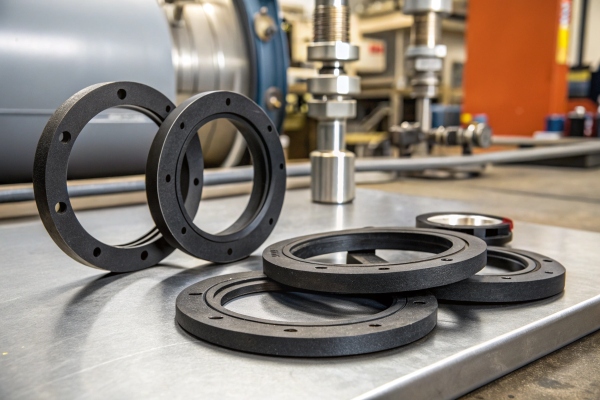Standards for rubber gaskets ensure product quality, performance, and compatibility across various industries. Understanding these standards can help you make informed decisions in selecting the right rubber products.
Rubber gaskets must meet specific international standards like ISO 90011 and ASTM D20002 to guarantee their durability and efficiency in sealing applications. These standards provide benchmarks for material properties and performance.
But what exactly are the key standards that define the quality of rubber gaskets? Let’s dive deeper into the most recognized certification systems used globally.
What is the ISO standard for rubber gaskets?
The ISO3 (International Organization for Standardization) plays a key role in defining the standards for rubber gaskets used worldwide.
ISO 9001 standards ensure that rubber gaskets meet quality and performance criteria. The most common standard for rubber sealing materials is ISO 9001, which focuses on quality management systems.
ISO 9001 standards for rubber gaskets mainly focus on the materials’ chemical composition, physical properties, and performance under different conditions. For example, ISO 2230 outlines the storage requirements to maintain rubber's performance and longevity. Understanding these standards helps ensure you choose gaskets that will stand the test of time, especially in demanding applications like HVAC systems or automotive sealing.
What is the ASTM standard for EPDM gaskets?
ASTM(American Society for Testing and Materials) provides standards that are particularly focused on the testing and performance of rubber materials, including EPDM (Ethylene Propylene Diene Monomer).
ASTM D2000 standards for EPDM gaskets focus on critical properties such as thermal aging, ozone resistance, and compression set, ensuring that EPDM performs effectively in extreme conditions.
The ASTM D2000 standard is particularly relevant for EPDM rubber gaskets. It specifies the material requirements for various grades of EPDM rubber used in industrial applications. EPDM gaskets are commonly used in environments exposed to extreme temperatures and ozone, making ASTM's performance tests crucial. Additionally, ASTM D4294 defines the testing for the adhesion properties of rubber to metal, ensuring a strong and durable bond.
What is the standard for rubber quality?
Rubber quality standards ensure that gaskets and other rubber products meet the required performance and safety levels for specific applications.
Quality standards for rubber products generally refer to a set of tests that determine the material's durability, resistance to chemicals, and ability to maintain functionality under pressure.
Rubber quality is measured through various tests, including tensile strength, elongation, hardness, and compression set. These tests help determine the rubber's suitability for different environments. ISO 9001 and ASTM D2000 are two of the most widely recognized standards that ensure rubber products are of the highest quality. For instance, rubber gaskets used in HVAC systems must pass specific durability tests to ensure long-lasting performance under fluctuating temperatures and pressures.
What is the ISO for rubber?
ISO 1629 standards for rubber cover a broad range of specifications related to materials, processing, and testing methods for different types of rubber.
ISO 1629 is the primary ISO standard for rubber materials, categorizing various types of rubbers based on their chemical composition and characteristics.
ISO 1629 defines rubber types, including natural rubber, synthetic rubber, and specific elastomers like EPDM, NBR, and silicone. This standard helps manufacturers select the right material for specific applications. Additionally, ISO 9001 ensures that production processes meet international quality control standards, guaranteeing consistency and reliability in rubber products across industries.
What is the ASTM standard for tear strength of rubber?
Tear strength is a critical factor in determining the durability of rubber products, especially for gaskets used in high-pressure environments.
The ASTM D6245 standard provides a method for testing the tear strength of rubber, ensuring that gaskets and seals can withstand mechanical stresses without failure.
ASTM D624 tests the ability of rubber to resist tearing when subjected to stress. This is crucial for gaskets used in industrial and automotive applications, where pressure and mechanical stress can cause failures if the material is too weak. The higher the tear strength, the more durable the gasket will be. This standard is often used in conjunction with other ASTM standards to determine overall material performance.
Is ISO the same as ASTM?
While ISO and ASTM are both recognized standards organizations, they differ in their scope and application.
ISO is a global body that sets international standards, while ASTM primarily focuses on material testing and performance standards in the United States.
ISO provides broader guidelines and frameworks that can be applied across industries and countries, while ASTM focuses on specific materials and their testing methods. For rubber gaskets, ISO standards might focus on manufacturing processes, while ASTM standards will deal with how to test the physical properties of the rubber under stress or pressure. Both are essential for ensuring the quality and reliability of rubber gaskets, but they serve different purposes.
What does ISO 2000 stand for?
ISO 20006 is a version of the ISO 9000 standard that was introduced to improve the effectiveness and consistency of quality management systems.
ISO 2000 refers to the ISO 9000:2000 series, which focuses on continual improvement and customer satisfaction in quality management.
ISO 2000 introduced more flexibility and a focus on customer satisfaction, shifting the emphasis from purely product standards to a broader approach to quality management. This version helped companies enhance their internal processes and improve communication with customers. It has since been replaced by newer versions, but its influence on global quality management practices remains significant.
Which ISO standard was replaced by ISO 9000:2000 standards?
The ISO 90007 standards have undergone several revisions, with the ISO 9000:2000 being one of the most significant updates.
ISO 9000:2000 replaced the older ISO 9000:1994 standard, bringing in a more modern approach to quality management and process improvement.
ISO 9000:1994 focused more on documentation and process adherence, while the 2000 version introduced a stronger focus on continual improvement and customer-centric processes. The 2000 revisions were designed to help businesses become more adaptable to market changes and improve long-term operational efficiency.
What is the difference between ISO and ASTM?
Although both ISO and ASTM set industry standards, their purposes and geographical application differ.
ISO is a global body that sets international standards, while ASTM focuses on standards specific to the U.S., especially for materials and testing.
ISO provides broader guidelines and frameworks that can be applied across industries and countries, while ASTM provides detailed specifications for testing the mechanical and physical properties of materials. For rubber gaskets, ISO standards might focus on manufacturing processes, while ASTM standards will focus on testing and performance.
How to get an ISO certification?
Achieving ISO certification8 demonstrates your commitment to quality and industry best practices.
To get ISO certified, a company must meet the standards outlined by ISO and undergo a thorough evaluation process by an accredited body.
To obtain ISO certification, companies must implement a quality management system that aligns with the standards of the specific ISO standard they are applying for. For example, ISO 9001 focuses on overall quality management, while other certifications like ISO 140019 focus on environmental management. The certification process involves audits, documentation of processes, and an evaluation by a third-party certification body.
Conclusion
Understanding the standards for rubber gaskets helps ensure that you select high-quality products for your projects. ISO and ASTM standards provide essential guidelines for performance, testing, and quality control, ensuring durability and efficiency.
Footnotes:
-
ISO 9001 focuses on quality management systems, ensuring products and services consistently meet customer requirements and regulatory standards. ↩
-
ASTM D2000 is an ASTM standard detailing performance specifications for rubber products, ensuring durability and reliability. ↩
-
ISO is an international standard-setting organization, ensuring consistency and quality across industries and products worldwide. ↩
-
ASTM D429 defines the method for testing the adhesion properties of rubber to other materials, ensuring strong bonding in rubber products. ↩
-
ASTM D624 provides methods for testing tear strength, crucial for ensuring rubber materials withstand mechanical stresses. ↩
-
ISO 2000 represents a key milestone in ISO 9000's evolution, focusing on customer satisfaction and continual improvement. ↩
-
ISO 9000:2000 introduced a more flexible, customer-centric approach to quality management. ↩
-
ISO Certification is awarded to organizations that meet the necessary standards for quality and management processes. ↩
-
ISO 14001 focuses on environmental management standards, ensuring that businesses minimize their environmental impact. ↩










